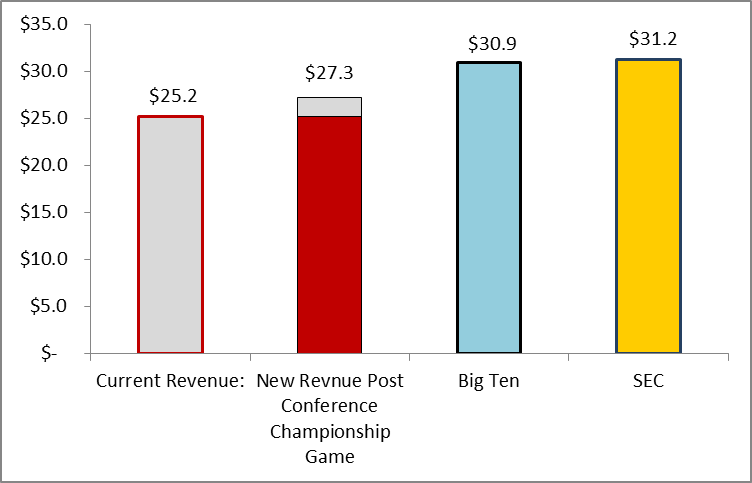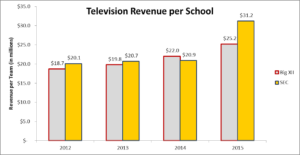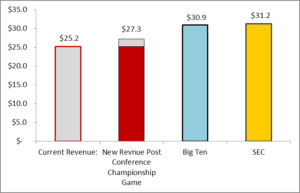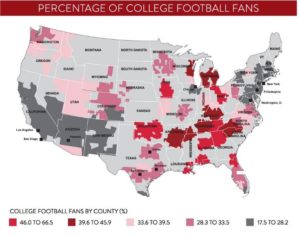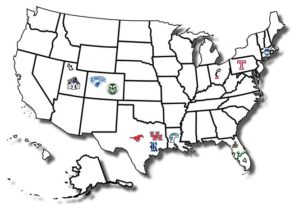Word Count: 1,126
Estimated Reading Time: 5 to 10 minutes
Summary
- Big XII expansion seems eminent with 12 candidates from the Group of Five currently being discussed
- Current television revenue per school in the Big XII is $25.2 million vs. the SEC at $31.2 million
- Texas and Oklahoma each make an estimated $40.2 million and $33.7 million respectively due to additional 3rd party television deals
- Adding two schools to the conference will need to help generate an additional $3.0 million per year per school in order to get the conference payout on par with the SEC ($31.2 million) and Big Ten ($30.9 million)
- My Top Three Expansion Candidates: Houston, BYU, Cincinnati
- I didn’t discuss the complexities of 3rd party television deals (Tier III TV rights). That is for another blog post
Introduction
Between 2010 and 2013, the Big XII was destabilized when Texas A&M, Missouri, Colorado, and Nebraska all left for greener pastures. The big catalyst for fleeing was the perceived unequal power of Texas and Oklahoma which ultimately led to unequal distribution of TV revenue. Six years later, it is safe to say that the Big XII is at another crossroads, and the topic of discussion once again is conference realignment/expansion.
If recent news is to be believed, the Big XII conference has narrowed its list of potential candidates for expansion down to fittingly 12 Group of Five candidates. And given Houston’s performance against Oklahoma yesterday afternoon, the chatter is only going to intensify.
The 12 Hopefuls
The potential schools stretch as far west as BYU to as far south as UCF and South Florida. And given where current member school West Virginia is located, it is not surprising that Cincinnati and Temple are being considered due to geographical reasons. I have compiled “resumes” of the 12 potential candidates for expansion (see chart below):
The tentative plan is to access the viability of each of the 12 schools, and the representatives of each of the 10 Big XII schools will decide what to do at the board of directors meeting on October 17th of this year.
In this high risk game of conference realignment and television contracts, I believe it is important for the Big XII to consider the longer term ramifications of expansion and not jump into a knee jerk reaction, adding two “subpar” schools just in an effort to get back to 12 teams. Specifically, the two schools that the Big XII adds will need to at minimum add an additional $3.0 million in incremental television revenue per school to be worth the trouble.
Why This Time is Different than 2012
On July 1, 2012 out of necessity, TCU and West Virginia became official members of the Big XII Conference. Both schools joined the Big XII after winning their conference championships the year before in football, and from a stability standpoint, the addition of these two schools was absolutely necessary to keep the conference from complete disintegration.
After surviving near annihilation, the Big XII member schools (specifically Texas) learned its lesson and voted to equally distribute Tier 1 and Tier II television revenues:
It’s hard to pinpoint exactly how much tangible value TCU and West Virginia brought to the Big XII. Over the past 3 years, Big XII television revenue has grown at a compound annual growth rate of 10.5%. And although its conference revenue is 19.2% less on a per school basis than the SEC (due to SEC network), there is absolutely no denying that revenue per school in the Big XII has stabilized and steadily grown.
On top of this, unlike other conferences, the Big XII allows schools to make additional television revenue through their 3rd party deals. At this point, Texas, Oklahoma, West Virginia, and Kansas each make an additional $8.5 to $15.0 million per year.
Given where the Big XII is currently, this time expansion talk feels a bit different. Rather than being about survival and necessity, the Big XII now can take its time and figure out which two schools will help them create the most incremental value to the current ten member schools.
Deregulated Conference Championship Game Doesn’t Necessitate the Big XII Expanding
Under the new NCAA rules which passed earlier this year, the Big XII will be able to hold a conference championship game in football while retaining its 10-member structure[1]. Previous rules stated that conferences needed a minimum of 12 members to play a championship game between two division winners. Given this, the Big XII doesn’t necessarily need to get to 12 members to reap the benefits of the conference championship game.
Research has shown that even at 10-members a Big XII championship would net an incremental $1.7 million to $2.4 million per year for each school[2]. Although going to 12 teams may help bolster the credibility of their conference championship game, from an incremental revenue standpoint, the Big XII can gain an additional $1.7 to $2.4 million for each of its members per year simply by adding a conference championship game without adding two new members:
So given where the Big XII is, the question it must ask it itself is will the addition of the two new schools net more than $3.0 million per year in incremental revenue?
Do Two New Schools = $3.0 million extra per school each year?
Given the geographical variety of the 12 potential candidates for expansion, I believe it is important to access the likelihood that the two additional schools in question will add at least $3.0 million in value per year.
Using the most recent update from Nielsen Year in Sports (pdf can be found here) you can see the density of college football fans by region:
Not surprising, when you overlay the 12 candidates for potential expansion (see map below), you will see that a majority of these candidates are in states that have high density college football footprints:
When it comes to capturing incremental television revenue, it’s imperative that the two schools that Big XII officials choose have locations that are highly saturated by college football fans and have an expansive alumni base that stretches from coast to coast. Both these reasons give the Big XII leverage in their discussions with ESPN and Fox, and ultimately drive up the value of their television deals.
As you can see from the above two maps, three schools standout to me as candidates that meet these two qualities: Houston, Cincinnati, and BYU.
Each of these three schools has footprints in high density locations. Specifically, the Nielsen TV market rankings of each of these locations are 10th, 35th, and 33rdrespectively. On top of this, these three schools on paper seem to meet the criteria of having alumni that expand from coast to coast in a similar fashion the alumni from the Big Ten schools (as an aside, the BIG Ten is absolutely killing it when it comes to TV deal negotiations. See article here.)
Conclusion
On October 17th when the Big XII gets together to decide the fate of its conference, it must keep in mind that the two schools they decide to add, must add at least $3.0 million in incremental television revenue per school to be worth the trouble. As the SEC and Big Ten have shown, 12 to 14 team conferences with their own conference network should net at least $30 million in revenue per school each year. Given where they Big XII currently is, expansion should only move forward if they can identify two schools that help them catch these two.

